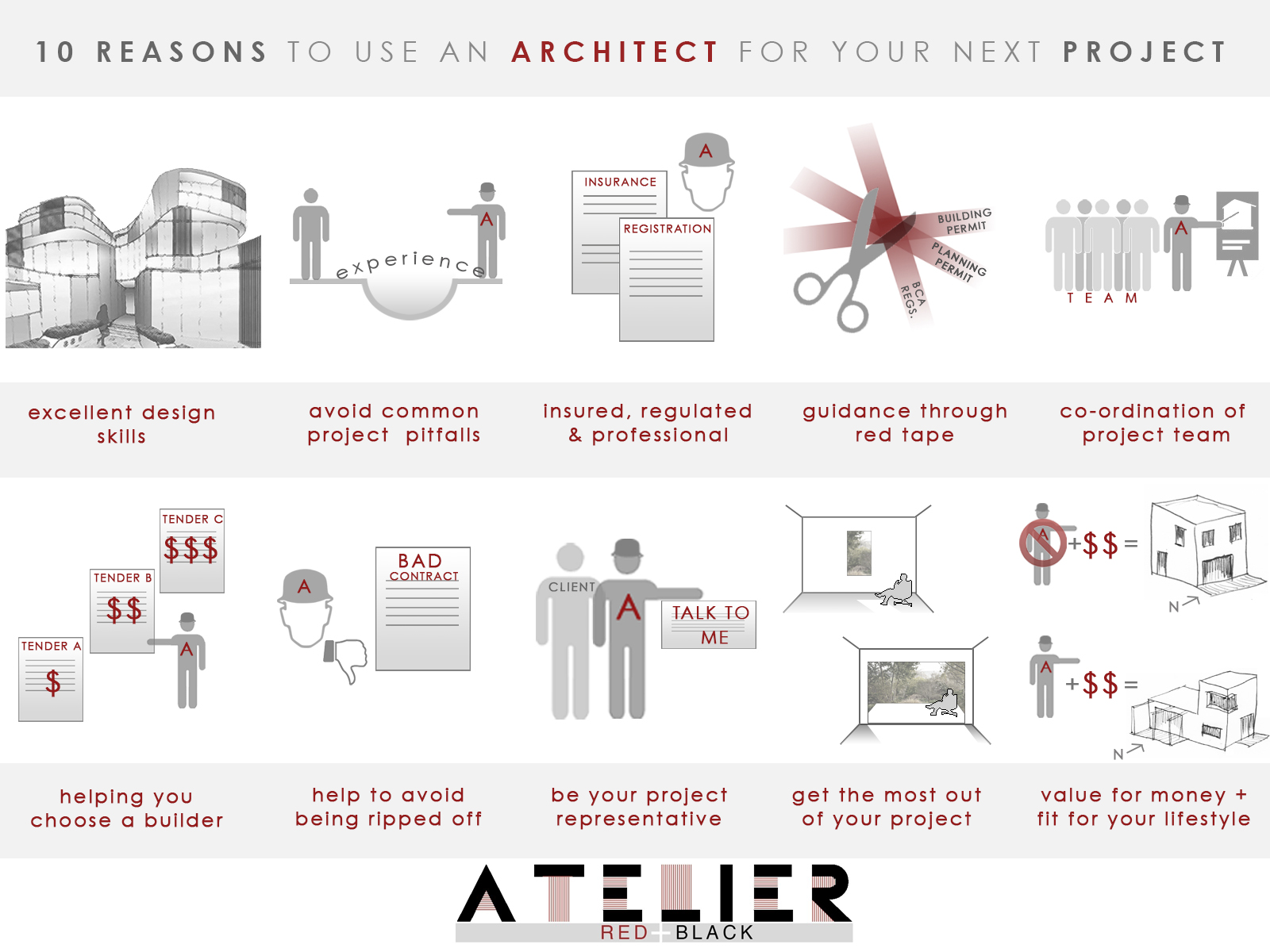1. Design skill
The number one reason you should use an architect to design your next home or extension is that architects as a rule have very extensive building design skills.
To become an architect in the first place, there is an extensive education path required to be travelled. This journey typically begins with a minimum 5 year stint in University, where skills are developed and honed through repeated exposure to project after project. Each of these university projects are critically analysed upon completion, often with ruthless tenacity to ensure that the most is learnt from each experience. This intensive university training is then complemented with a minimum of 2 years ‘real world’ project experience under the supervision of registered architects.
All this means that by the time you engage an architect they will quite likely have at least a decade of design training to unleash on your project. A high quality design will make the most substantial difference to your project. Your building will be tailored to the environment to efficiently keep you cool in summer and warm in winter. It will be designed into the context of your land to maximise the best aspects of your site. Finally it will be sculpted to compliment your needs, wants and aesthetic taste. A high quality design will improve your everyday life.
2. Avoiding the pit falls
Building a new building, or altering an existing one, is a very complex activity which carries with it significant financial risks. Procuring a new project can also take a substantial amount of time from day one in the design, to moving in to a completed building. During this long project lifespan, there are literally hundreds of decisions to be made which all have implications. There are also very many traps and pitfalls to avoid. The key to avoiding these traps is experience. Architects are well placed with their knowledge and years of experience to guide you through this process.
3. Insured, regulated and professional
All architects in Australia must be registered with the Architects Registration Board in the state where the project site is located. In order to be registered, a three stage examination process must have been successfully passed and the Architect MUST carry professional Indemnity Insurance. This regulation protects the consumer from dealing with unregulated and uninsured designers. To check if a person is an architect a simple and free online search can be undertaken on the registration board’s website.
For projects in Victoria follow this link
Architects Registration Board of Victoria www.arbv.vic.gov.au
This mandatory registration provides peace of mind to those engaging architects that the person they are dealing with will be an experienced professional who can get the job done.
4. Guidance through planning and red tape
Building is highly regulated by laws from all three levels of government. Typically this starts with local government planning schemes, in order to achieve a planning permit. Occasionally this process can take a detour through to the Victorian Civil and Administrative Tribunal (VCAT). This tribunal is essentially a branch of the Supreme Court set up to hear various types of cases including building and planning disputes.
Upon achieving a planning permit the next stage is to coordinate a building permit. This level of regulation is to ensure that the building when constructed is safe to use, structurally sound and complies with the Building Code and relevant Australian Standards.
The complexities of the various regulations makes it somewhat of a minefield for those inexperienced in the local setting. Again architects have the experience and knowledge to navigate this path and keep the project on track.
5. Coordinating the team
The architect cannot work in isolation. All projects will require a team of professionals all doing their specific role. As a minimum, a building surveyor and a structural engineer will be required. Depending on the project this can include many more consultants such as, town planning consultants, land surveyors, hydraulic / mechanical / services engineers, acoustic engineers, geotechnical engineers, landscape architects and urban designers. Needless to say this team effort can require significant coordination to ensure that everyone is on the same page.
An experienced architect will have working relationships with the full range of consultants. Furthermore they will brief the consultants and lead the project team on your behalf to ensure that there is no unnecessary work done and that it is all coordinated into a cohesive final design.
6. Tendering
Another aspect of the architect’s role is organising the project tender. This process enables reputable builders to bid on their price to construct the project. This tender process often enables the client to get better value for money by making the builders compete for the project in terms of price and construction time frame. The architect will ensure that the process is a level playing field for all of the builders, controlling the timing and dispersal of information and responding to any builder queries.
7. Building on your terms (contract selection)
When signing up for an ‘off the plan’ house from a builder or even a new car from a dealership you are required to sign the seller’s contract. If you want that house or that car you have no choice but to sign their contract. This might mean that they have 18 months to deliver their end of the bargain whilst you must provide your end immediately. This is not necessarily fair for you as the purchaser, but your only alternative may be not to proceed with the purchase.
However, when using an architect, you are able to have your choice of building contract. This can be used to protect your interests and make it more likely that the project is completed within your time and budget. With all building contracts the architect may make suggestions as to which would be appropriate for the specific project, however legal advice should be taken to ensure the selected one best suits your needs.
8. Being your representative
Through the entire process with the exception of assessing, valuing and certifying builders claims, the architect is acting as your representative and agent. If the local council has an issue, the engineer has a question, or the builder needs clarification, the architect is their point of call. This means that you don’t have to be the expert to get an expert result.
9. Getting the most out of the project
To get the most out of your project, the design process is critical. Architects have the experience to work through this process with their clients and to push the boundaries of client expectations. Often in a first meeting, a client will have a fixed idea of what they want in their project. The architect will listen to the client and work with them to establish alternative options as well as identify limitations which the client was originally unaware of. This dialogue of ideas between client and architect continues throughout the project, providing an end result which is often far beyond the clients initial expectations.
10. Value for money
Building is an expensive and complex activity to undertake. To do it well requires substantial time and skill in design. Some critics of architects say that they charge too much. However what the client is paying for is the architect’s time to think, design and draw their project. Architects are with the project for its entirety and the greater the time, thinking, designing and drawing, the better the result. Some clients go into the project restricting the architect’s scope of services and negotiating the minimum fees possible. Unfortunately these clients often miss out on most of the value to be had.

As you have seen the Architect provides experience and professionalism across a broad range of tasks over the life of the project. They will push the bounds of the brief to create a building uniquely suited to the client’s needs. They will engage their substantial design skills to achieve the most out of the site and wider context. Most importantly they will be with the project and the client from start to finish, providing them with value and advantage along the way.
Architecture is for everyone.
Contact Us
Feel free to contact us with questions or feedback:
Latest Post
- A crisis of trust February 10, 2020
- The Square and the Park. October 28, 2019
- Fixing The Building Industry – A Wishlist September 12, 2019
- 2019 NATIONAL CONFERENCE DAY 2 June 24, 2019
- 2019 National Conference Day 1 June 22, 2019



Leave a Reply